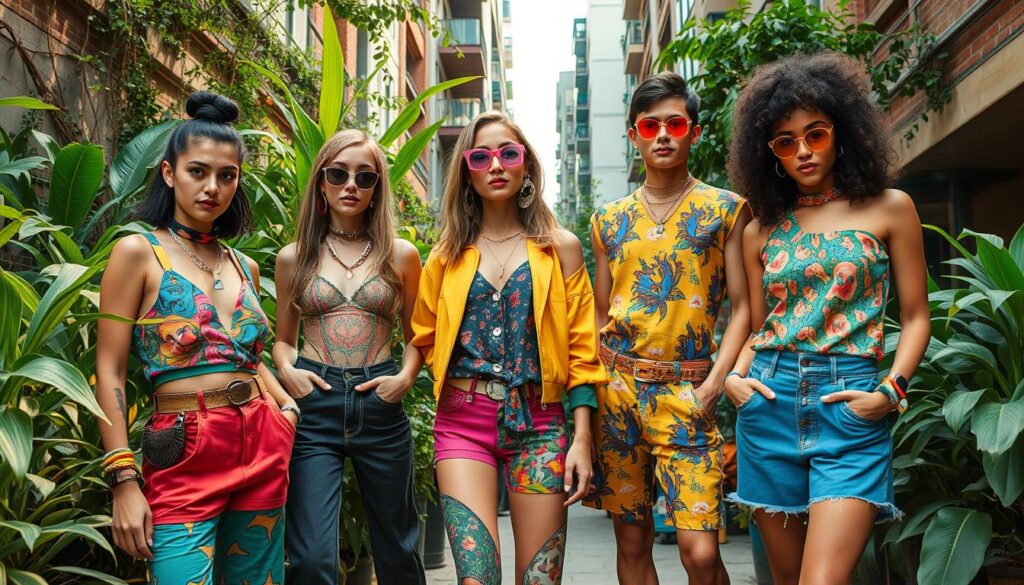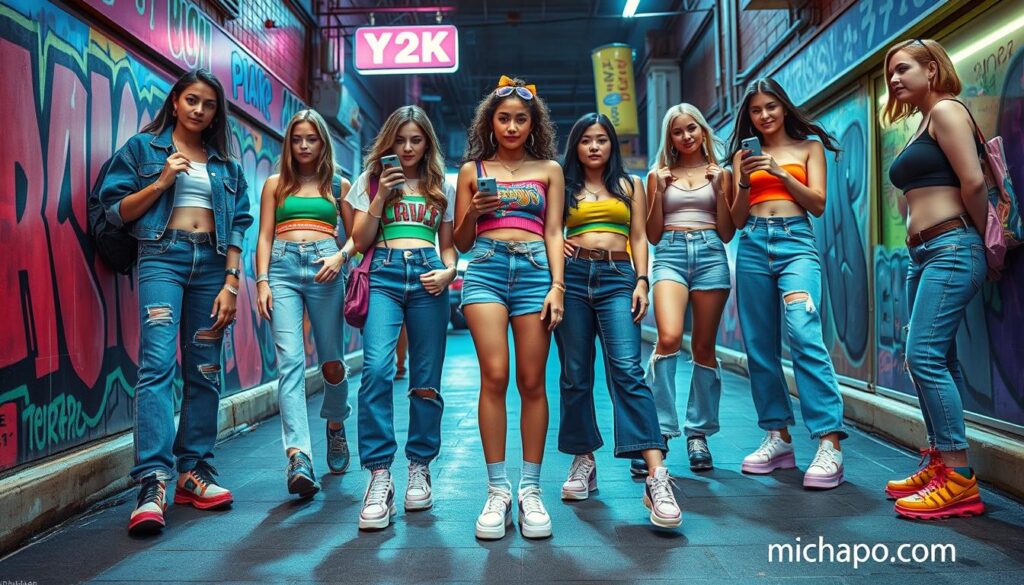Table of Contents
90s Fashion: Trends That Defined a Decade
The 1990s brought a big change in fashion, moving from the fancy styles of the 1980s to something more simple1. This change was huge, thanks to the rise of supermodels and the grunge look. Minimalism became big in high fashion, and old styles came back too.
Technology and caring for the planet also played big roles in 90s fashion. People from all over the world influenced fashion trends. It was a time of creativity, where both designers and shoppers explored new styles.
Key Takeaways
- The 1990s saw a shift from the opulent 80s to a more casual and minimalist approach in fashion.
- The rise of supermodels like Linda Evangelista, Cindy Crawford, Naomi Campbell, and Christy Turlington defined the decade.
- The grunge aesthetic, pioneered by musicians like Nirvana, made its mark on the runway.
- Minimalist designers like Calvin Klein and Prada led the way in simplifying high fashion.
- Designers drew inspiration from various historical eras and global cultures, creating a nostalgic and fantasy-driven aesthetic.
Rise of Supermodels
The 1990s saw a huge rise in supermodels. Names like Linda Evangelista, Cindy Crawford, Naomi Campbell, and Christy Turlington became well-known2. They were more famous than the clothes they wore, captivating the world with their big personalities. They became celebrities in their own right.
The supermodels showed what a powerful woman of the 1990s looked like. They set new standards for fashion and beauty.
The Big Four: Linda, Cindy, Naomi, and Christy
In January 1990, British Vogue’s cover featured five models. Naomi Campbell, Linda Evangelista, Christy Turlington, Tatjana Patitz, and Cindy Crawford were the pioneering supermodels2. Gianni Versace paid them more than double to walk for Versace, showing their high demand and value3.
The rise of these models made the fashion industry very popular and profitable3.
Shift to a New Generation of Waifs
As the decade went on, a new generation of models appeared. They were more fragile and looked younger. Models like Kate Moss, Shalom Harlow, and Amber Valletta brought a new look to the industry.
This new look was perfect for the grunge and minimalist trends. Their delicate and unkempt looks fit the casual and simple styles.
The fashion industry started to focus more on celebrity endorsements. In 1999, Allure magazine said “Nobody cares about models anymore.”2 Despite efforts to find new supermodels, the original ones like Naomi Campbell, Cindy Crawford, and Linda Evangelista, are very famous3.
Fashion brands now prefer to work with a variety of niche celebrities and influencers. They target smaller communities instead of relying on a few supermodels23.
Grunge Aesthetic
The grunge fashion trend started in the mid-1980s and became popular in the 1990s4. It came from Seattle’s music scene, as a reaction against the luxury of the 80s. Kurt Cobain, Nirvana’s lead guitarist, played a big role in grunge fashion’s rise4.
Today, teens and Gen Z are bringing back grunge fashion. They love its message of being different and not following the crowd45.
In the early 1990s, grunge fashion became popular in northwestern America4. It was a shift from punk’s bold style to something more casual and everyday. Bands like Nirvana and Soundgarden made grunge famous with their look of ripped clothes and messy hair4.
Men’s grunge in the 90s included graphic shirts, flannel, and cargo pants4. Women wore dark and distressed clothes like oversized plaid shirts and chunky boots4. This style’s mix of loose and androgynous elements is why it’s loved by many today4.
Runways in AW’22 showed off shredded denim and flannel shirts, proving grunge is back4. Its message of being true to oneself is why it keeps attracting new fans5.
Minimalism Reigns
The 1990s saw a big change in fashion, moving towards minimalism. This was a reaction to the over-the-top styles of the 80s6. Designers like Calvin Klein, Helmut Lang, and Prada focused on simple designs. They used clean lines, soft colors, and quality over fancy details6.
The slip dress became a must-have item, and cargo pants and sweatshirts made their way into high fashion6.
Calvin Klein and Prada Lead the Way
Calvin Klein and Prada led the minimalist fashion movement in the 90s6. They introduced a style that was simple and practical. This was a big change from the flashy 80s7.
Their designs featured clean lines, neutral colors, and high-quality materials. This set the stage for 90s fashion6.
Slip Dresses and Utilitarian Looks
The slip dress became very popular in the 90s. It was worn for both formal and casual occasions6. It was often paired with a simple white t-shirt for a relaxed look6.
Cargo pants and hooded sweatshirts also became essential items. They came from brands like The Gap and fit perfectly with the decade’s casual vibe7.
Today, the minimalist style of the 90s continues to influence fashion. Brands like COS, Acne Studios, and A.P.C. draw inspiration from the 90s’ clean designs6. This shows how lasting the 90s minimalism trend really is6.
“The 90s fashion trend embraced minimalism, transitioning from the bold and neon colors of the 80s to clean lines and neutral tones.”7
| Key Characteristics of 90s Minimalism | Examples of 90s Minimalist Designers |
|---|---|
|
|
Retro Revivals
In the 1990s, fashion became nostalgic, drawing from many historical eras8. Designers like Christian Lacroix, Vivienne Westwood, and Jean Paul Gaultier mixed styles from the 19th century to the 1970s. This blending of eras showed a desire to explore the past as the millennium approached.
Designers Cycle Through Vintage Inspirations
The 90s saw a comeback of retro fashion, with designers revisiting past styles8. Grunge, popularized by bands like Nirvana, is a key trend from the 90s8. Streetwear, influenced by hip-hop, also shaped 90s fashion8. Minimalism brought a clean, feminine look to 90s fashion8.
Accessories like chokers and mini backpacks have also returned8. The interest in 90s fashion is growing, with online courses and certificate programs8. Designers continue to show their unique takes on 90s styles.
“Fashion is about dressing according to what’s fashionable. Style is more about being yourself.” – Oscar de la Renta
| Vintage Inspiration | 90s Icon | Modern Resurgence |
|---|---|---|
| Grunge | Nirvana, Pearl Jam | Zendaya, Timothée Chalamet9 |
| Slip Dress | Gwyneth Paltrow, Sarah Jessica Parker | Rihanna, Taylor Swift9 |
| Denim Overalls | TLC, Aaliyah | Gigi Hadid, Kendall Jenner9 |
| Choker Necklace | Britney Spears, Spice Girls | Rihanna, Ariana Grande9 |
| Platform Shoes | Lady Gaga, Taylor Swift | Lady Gaga, Taylor Swift9 |
| Bucket Hat | Hip-Hop Community | Rihanna, Bella Hadid9 |
| Neon | Rave Culture | Mainstream Fashion9 |
The fashion world loves to go back in time, revisiting and reimagining old styles10. From the 70s to the 80s, these retro looks are back, showing the lasting impact of the past on today’s 90s retro fashion.
Deconstruction and Avant-Garde
In the 1990s, Japanese designers like Rei Kawakubo and Martin Margiela11 led the way in avant-garde and deconstructionist fashion. They pushed the limits of traditional fashion, using unusual shapes, unfinished edges, and repurposed materials11. What started as a bold move became a mainstream trend, shaping the view of fashion as an art form12.
Martin Margiela and Rei Kawakubo Influence
Maison Margiela, Y-Project, Ottolinger, Rick Owens, and Comme des Garçons are key players in deconstruction fashion11. Maison Margiela is famous for its bold, avant-garde looks, using unexpected materials and oversized designs11. Y-Project stands out with its daring, gender-free designs that blend deconstruction11.
Ottolinger is known for its extreme deconstruction and perfect tailoring, creating striking, avant-garde pieces11. Rick Owens’ designs are a perfect example of deconstruction, featuring architectural shapes, rough textures, and a futuristic vibe11. Comme des Garçons, led by Rei Kawakubo, is a trailblazer in deconstruction, challenging beauty norms with unique silhouettes and designs11.
“Deconstruction fashion has been trending in 2024, captivating fashion fans with its raw, unfinished aesthetic.”11
The 1980s and early 1990s saw the birth of deconstruction fashion, thanks to designers like Martin Margiela, Yohji Yamamoto, and Rei Kawakubo11. This style is marked by asymmetry, unfinished looks, rough textures, and unusual materials11.
| Designer | Deconstruction Fashion Influence |
|---|---|
| Martin Margiela | Avant-garde aesthetics, unconventional materials, and oversized silhouettes |
| Y-Project | Gender-bending, free-spirited designs incorporating deconstruction elements |
| Ottolinger | Radical deconstruction and immaculate tailoring, charged silhouettes and avant-garde aesthetics |
| Rick Owens | Architectural silhouettes, distressed textiles, and a dark, futuristic aesthetic |
| Comme des Garçons | Pioneering label in deconstruction fashion, challenging conventional beauty standards with unconventional silhouettes and designs |
The “Fashion in the Nineties” exhibition at the Museum at FIT showcases pieces by Alexander McQueen, Vivienne Westwood, Helmut Lang, Hussein Chalayan, and Maria Cornejo13. It highlights the variety and depth of deconstruction and avant-garde fashion in the 1990s13.
Fantasy and Nostalgia
In the 1990s, designers started to draw inspiration from fashion fantasy and nostalgia. John Galliano was at the forefront, known for his bold, theatrical designs. These were influenced by many historical and cultural sources14.
John Galliano’s Theatrical Designs
Galliano’s work, whether for Givenchy or Dior, was a mix of different styles. He combined elements from the 19th century, the 1930s, and global traditions. This created a world of fantasy and escapism that amazed everyone14.
“Galliano’s collections were a pastiche of sartorial references, blending elements from the 19th century, the 1930s, and various global traditions, creating a sense of fantasy and escapism that captivated the fashion world.”
Galliano’s designs were a big change from the minimalist and grunge styles of the early 1990s. His shows were like a journey to different times and places. They were full of life and color14.
The late 1990s saw a big shift in culture, with a focus on fashion fantasy and nostalgia. People were looking for comfort in familiar styles and themes, away from the fast pace of technology15.
Galliano’s work inspired many to explore their own theatrical designs. He encouraged people to embrace their fantasies and find comfort in the past14.
Technology Influences Fashion
The 1990s saw a big change in fashion and technology. The Internet and digital photography became key. Photographers started using digital cameras for runway shows. This let images spread fast around the world16.
This change made how we see and share fashion different16.
Online shopping also changed fashion a lot. By the end of the decade, brands like Kenneth Cole saw big sales online17. This showed people wanted to shop online more.
It let shoppers see more fashion from home. This changed how the industry sold clothes and how people bought them.
Designers started using tech in their designs. They used circuit board patterns and LED lights in clothes16. This showed the fashion world was ready to use new tech.
As the 90s went on, fashion and tech got closer. Digital photos and online shopping were big changes. These changes are felt in fashion today1617.
“The future belongs to those who believe in the beauty of their dreams.”
–Eleanor Roosevelt
90s Fashion
The 1990s was a time of great change in fashion. It saw a mix of different styles that made the decade unique. The shift was from the fancy 1980s to a simpler, more casual look18.
Supermodels like Naomi Campbell, Cindy Crawford, Christy Turlington, and Linda Evangelista were everywhere. They were on magazine covers and runways, setting the fashion trends19. Later, “heroin chic” came in, led by Kate Moss. This introduced a new, thinner beauty standard19.
Grunge fashion became popular in the mid-1990s. It included flannel shirts, ripped jeans, and Doc Martens. It showed the era’s rebellious side19. At the same time, minimalism was big, thanks to Calvin Klein and Prada. They made slip dresses and high-shine fabrics like satin and silk popular19.
The 1990s also brought back old styles, from the 1970s to the 1980s. Designers like Martin Margiela and Rei Kawakubo pushed fashion boundaries. They changed how clothes looked and felt18.
New tech also changed 90s fashion. It brought in new materials and ways to make clothes18. The decade also started to care more about the environment. Eco-friendly fashion collections began to appear18.
The 1990s was a time of many fashion trends. It was influenced by supermodels, grunge, and minimalism. These styles are part of why we dress the way we do today181920.
Environmentalism and Reuse
In the 1990s, the fashion world started to care more about the planet. Brands like Esprit and Moschino made clothes that were good for the environment. Designers like Martin Margiela and Lamine Kouyaté from Xuly.Bët showed how to make new things from old materials21.
This change showed that people wanted clothes that didn’t harm the Earth. It was a big step towards making fashion more sustainable21.
Sustainable and Eco-Friendly Collections
As people became more aware of the environment, fashion brands started to act. Esprit made a “Recycle” line using recycled materials. Moschino used recycled fabrics and old materials in their designs21.
Designers like Martin Margiela and Lamine Kouyaté of Xuly.Bët also focused on reuse. Margiela turned old items into new, cool clothes21. Xuly.Bët showed how you can make stylish clothes from things that would normally be thrown away21.

The 90s were a time of big change in fashion. Brands and designers started making clothes that were better for the planet2122. This was because people wanted clothes that didn’t harm the Earth22.
This was the start of a new way of thinking in fashion. The 90s were the beginning of a more eco-friendly fashion world212223.
| Environmental Impact of the Fashion Industry | Statistics |
|---|---|
| Textile Waste |
|
| Water Usage and Pollution |
|
| Carbon Emissions |
|
“The rise in polyester, nylon, and acrylic fabrics in clothes causes environmental problems23. Fast fashion’s use of unsustainable materials harms the environment23.”
The 90s were a turning point for fashion and the environment. Brands and designers started making clothes that were better for the planet. This showed a growing awareness of the industry’s impact on the environment212223.
Global Wardrobe
In the 1990s, fashion became more global, with designers inspired by many cultures24. But, this trend also led to debates about cultural appropriation. Designers like John Galliano were criticized for using cultural symbols like Native American war bonnets in their work for Dior24.
As time went on, people started to talk more about the need for respectful fashion. They wanted the industry to show diverse cultures in a better way.
Cultural Appropriation in Fashion
In the 1990s, designers mixed cultural elements into their designs24. This was meant to celebrate different cultures, but it often caused controversy24. Designers like John Galliano were criticized for using important cultural symbols without understanding their true meaning24.
As the fashion world got more connected, people realized the importance of being thoughtful with cultural representation24. This led to designers being more careful and working with communities to make sure their designs were respectful and true to the culture24.
The 1990s were a turning point in fashion, with designers exploring many cultures24. But, this also brought up the issue of cultural appropriation, leading to talks about how to show diverse cultures in a respectful way24.
“Fashion is a global language, but it must be spoken with respect and understanding for the cultures it celebrates.”
Casual and Athleisure
In the 1990s, fashion changed a lot, moving towards comfort and ease. The rise of 90s casual fashion and athleisure changed how people dressed. Brands like The Gap and Tommy Hilfiger made this laid-back style popular. It showed a shift towards a more casual, sporty look25.
The athleisure trend mixes athletic wear with casual clothes, shaping the fashion world. It’s about mixing sporty pieces with more formal items for a smart look25. Tailored clothes are key, fitting well to look polished and refined25.
For casual athletic looks, sneakers or stylish loafers are good choices25. Accessories like bold watches, delicate necklaces, or cool sunglasses add to the look25.
The 90s casual fashion and athleisure are popular again, thanks to Pinterest26. People love tags like “90s Athleisure” and “Vintage Sportswear,” showing the era’s lasting appeal26.
| Keyword | Search Volume |
|---|---|
| 90s casual fashion | 6k |
| athleisure | High |
| the gap | Medium |
| tommy hilfiger | High |
| jeans | Very High |
| khakis | Medium |
The 1990s brought a big change in fashion, moving towards comfort. The 90s casual fashion and athleisure trends are big today. Brands like The Gap and Tommy Hilfiger helped shape this style, which is loved by many.
“Athleisure has become a significant trend in recent years, shaping the fashion world by storm.”
Y2K Fashion
As the 1990s ended, fashion looked ahead to the new millennium, creating the “Y2K” style. This look was all about futuristic vibes, with low-rise jeans and crop tops leading the way. These pieces became staples of early 2000s fashion27.
The fashion world was excited and a bit nervous about Y2K. This was reflected in the bold, playful way people dressed27.
Low-Rise Jeans and Crop Tops
The Y2K era was all about bright colors like pink, blue, orange, and green. These colors made a big statement in fashion27. Big logos were also big in Y2K fashion, showing off status and style27.
Today, high fashion brands like Louis Vuitton are bringing back Y2K elements in their designs27.
- Y2K fashion is all about shiny fabrics like vinyl and PVC, giving off a futuristic look27.
- People of all ages are loving Y2K fashion, with older folks feeling nostalgic and younger ones finding it fresh27.
- Instagram and TikTok have helped make Y2K fashion popular across generations27.
- There’s a big push for sustainable fashion, with thrift shopping becoming more popular27.
- Influencers are key in bringing back Y2K fashion, sharing tips and promoting eco-friendly choices27.
- Sneaker culture has also adopted Y2K style, with brands like Balenciaga and Yeezy releasing Y2K-inspired shoes27.
Fashion trends usually come back every 20 years, as new generations discover old favorites28. Y2K fashion, beauty, and music are making a comeback, with a big spike in interest for ’90s mom jeans in 202128. Thrifting is getting more popular as people look for sustainable fashion options28.
| Trend | Celebrity Influence |
|---|---|
| Lace-up leather pants | Kim Kardashian, Kendall Jenner, Addison Rae29 |
| Velour tracksuits | Kim Kardashian, Kendall Jenner, Addison Rae29 |
| Cargo pants | Hailey Bieber, Hillary Duff, Zendaya29 |
| Cardigans | Outfits worn by characters in Euphoria29 |
| Cropped bomber jackets | Reminiscent of Megan Fox in Jennifer’s Body29 |
| Fur-trimmed duster coats | Olivia Rodrigo, Rachael Leigh Cook in Josie and the Pussycats29 |

Today, fashion is cheaper and more focused on making money, thanks to big companies cutting costs28. Social media is speeding up trend cycles, making old trends come back faster28. People are choosing thrifted items over fast fashion, showing a desire for more sustainable choices28.
On TikTok, there’s a focus on finding your own style instead of following trends28. For decades, young people have made old clothes their own, creating unique styles28. Even ugly clothes can be trendy, drawing attention from mainstream fashion28. Who wears the trend can greatly influence its success, with looks often being driven by attractiveness28.
Conclusion
The 1990s left a lasting impact on fashion, shaping today’s styles. Iconic supermodels like Linda Evangelista and Naomi Campbell30 were key. The grunge look, with flannel shirts and Doc Martens, also made a big splash31.
Designers like Calvin Klein and Prada brought minimalism to the forefront30. Vintage and experimental styles added to the decade’s rich fashion scene. John Galliano and Rei Kawakubo’s use of technology and fantasy also left a mark.
While some trends, like cultural appropriation, are now under scrutiny, the 90s’ fashion remains influential. Brands like Saint Laurent and Gucci have drawn from the decade’s styles. From grunge to velvet, the 90s continue to inspire fashion today30.
FAQ
What was the significance of the supermodel phenomenon in 1990s fashion?
How did the grunge aesthetic influence 1990s fashion?
What was the impact of minimalism on 1990s fashion?
How did retro revivals influence 1990s fashion?
What was the impact of avant-garde and deconstructionist design on 1990s fashion?
How did technology impact the fashion industry in the 1990s?
How did environmentalism and sustainability influence 1990s fashion?
How did the 1990s fashion trends influence contemporary styles?
Source Links
- A 1990s Fashion History Lesson: Supermodels, Grunge, and the Dawn of the Digital Age
- In an industry fixated on youth, why are 90s supermodels still so influential?
- What Made The 90s Supermodels So Special? — Eternal Goddess
- Manufacturing Platform for Apparel Industry | Fast & Sustainable – Fashinza
- Grunge Fashion: The History Of Grunge & 90s Fashion
- Mastering 90s Minimalism: Elevate Your Men’s Fashion Game with Timeless Style — The Rakish Gent
- A 12 Piece 90s Minimalist Winter Capsule Wardrobe – livelovesara
- 90s Revival Fashion: Unleashing Retro Vibes for a Modern Wardrobe
- Retro Revival: How 90s Fashion Trends are Dominating 2024 Style – Retro Relevance
- Retro Revival: Nostalgic Fashion Trends Making a Comeback
- The Rise of Deconstruction Fashion
- Reinvention & Restlessness: Fashion in the Nineties
- A New Exhibition at FIT Examines the Ever Alluring 1990s as an Era of Reinvention and Restlessness
- 1990s Fashion Trends: Grunge, Bohemian, Glamour, & School Girl
- 20 Iconic 1990s fashion trends to add to your 2024 wardrobe
- Fashion Technology – Changes Affecting Lifestyle Fashion History.
- The Rise of Retro: Why 90s Style Is Back in Fashion and What It Means for Retailers – Knowledge Leader – Commercial Real Estate Content Hub
- 90s Fashion – Trends + Outfit Ideas to Buy Now
- 1990s in fashion
- 20 Forgotten ’90s Fashion Trends Poised to Make a Comeback
- The Environmental Crisis Caused by Textile Waste
- Fast Fashion: Its Detrimental Effect on the Environment
- Mass-Produced Clothing Causes Serious Air, Water Pollution Worldwide
- The Eight Trends That Defined High Fashion in the 1990s
- Smart Casual Athleisure Style
- 90s Sportswear
- The Endurance of Y2K Fashion in Cross-Generational Trends
- Why do the ugly fashion trends from our youth keep coming back?
- The Best Y2K Trends to Try, From Floor-Length Cardigans to ‘Coyote Ugly’-Style Leather Pants
- 1990s fashion: A brief history of what we wore | CNN
- 1990s fashion history
 Today News, Tech, Business, Digital Business etc Michapo.com
Today News, Tech, Business, Digital Business etc Michapo.com

